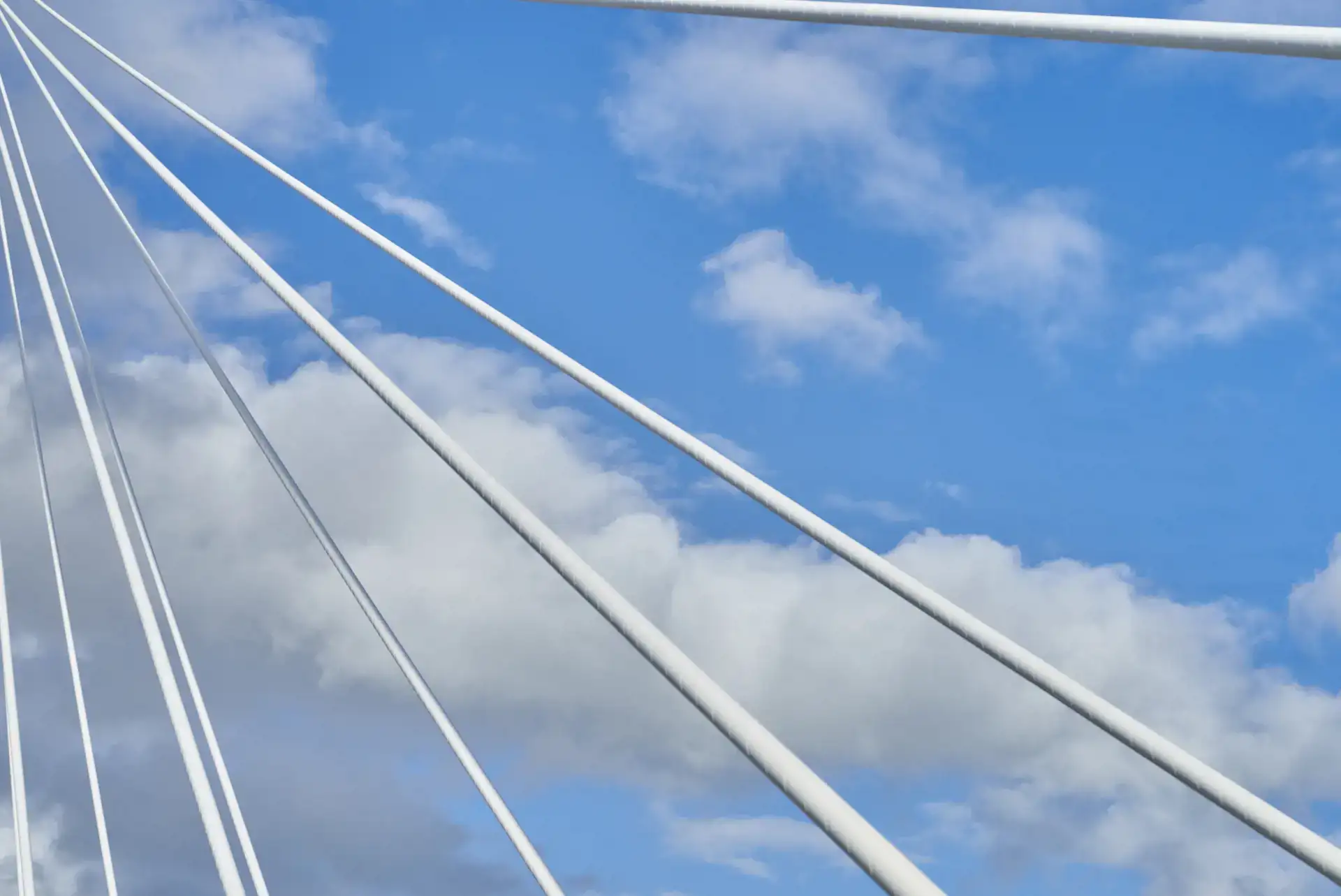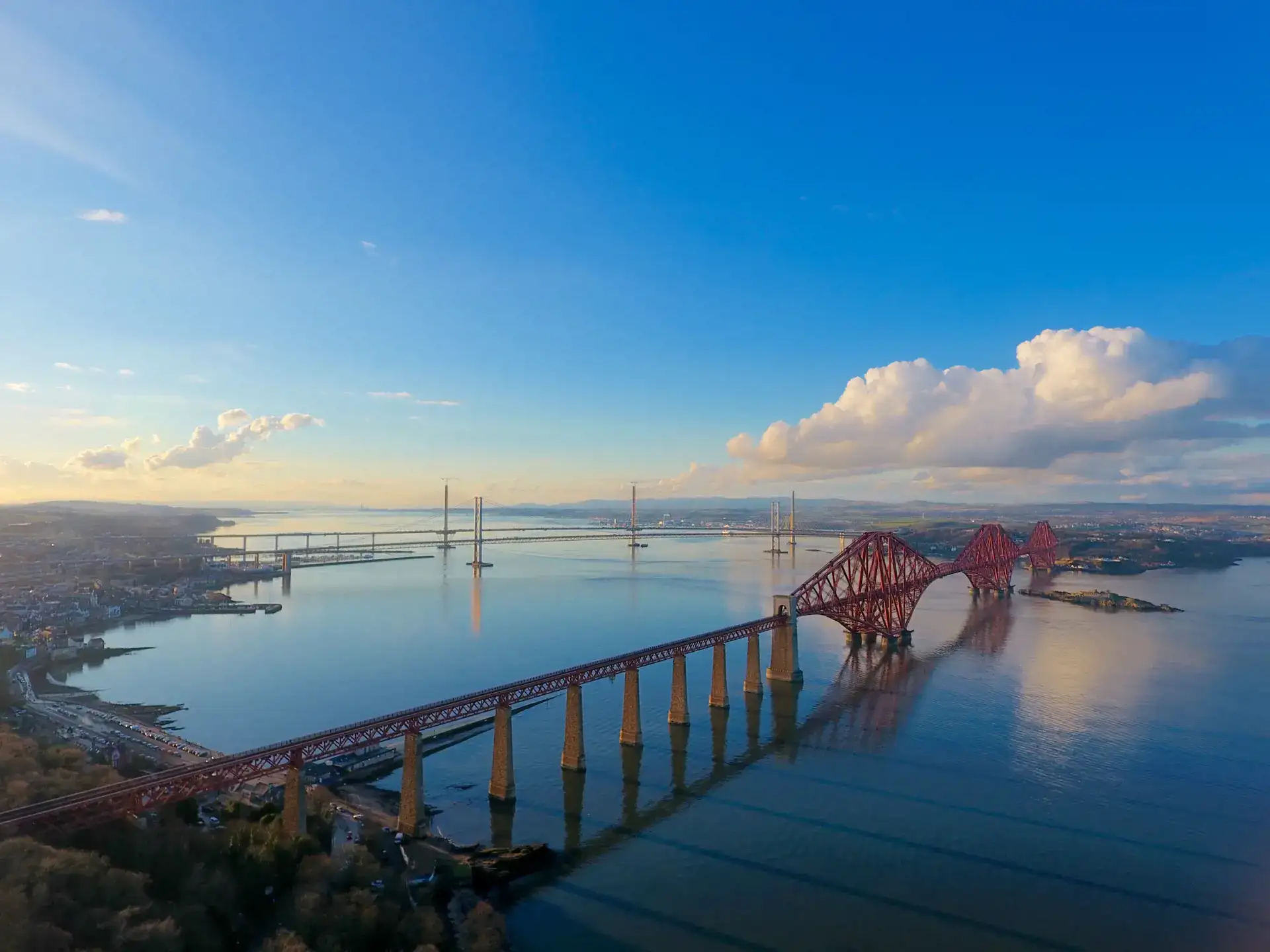Due to essential maintenance the WEST Footpath/Cycleway is CLOSED except during weekends, please use the EAST Footpath/Cycleway.
Open to all permitted vehicles.
Access Restrictions
Visit the Forth Bridges
To truly appreciate the bridges, you need to get on them!The Forth Bridge
Designed by John Fowler and Benjamin Baker, the Forth Bridge is a marvel of Victorian engineering. It was originally to be designed by Thomas Bouch but his plans were abandoned when disaster struck his Tay Bridge in 1879.
Construction work was completed by Tancred and Arrol, a pioneering engineering business based in Glasgow which later became Sir William Arrol & Co.
The bridge opened in 1890. A staggering 53,000 tonnes of steel and 6.5 million rivets were used in construction. The first major structure in Britain to be constructed of mild steel, at 2.5km long, the bridge boasted the world’s longest span. In the heyday of rail travel, it marked an important milestone in bridge design and construction.
With its iconic industrial appearance, the Forth Bridge remains one of the greatest cantilever-trussed bridges.
An international landmark, the Forth Bridge is viewed with great affection and nicknamed ‘Our Grand Old Lady’ by local people. In 2016, it beat Edinburgh Castle and The Kelpies in a public vote for Scotland’s greatest manmade wonder. It has inspired the design of a bridge in Pokémon, a book charting the lives of The Briggers (the men and boys who constructed the bridge), and a 4.7m Lego model which attracted over 10,000 votes to be made into an official kit.
‘Painting the Forth Bridge’ became a phrase synonymous with a never-ending task. But the bridge doesn’t need constant painting anymore.
Originally, a hand-operated paint mixer was used but nowadays, a long-lasting epoxy paint system containing glass flake is applied. The expectation is that the bridge will now only need to be painted every 25 years or so. The distinctive red colour was created to emulate the red oxide colouration of the bridge when it first opened, which had been manufactured by Craig & Rose of Edinburgh.
The Forth Bridge is now a UNESCO World Heritage Site and remains in use as a vital passenger and freight rail link across the Firth of Forth, carrying 200 trains a day.
To experience the Forth Bridge up close, you'll need hop on a train at Dalmeny Station (South Queensferry) or North Queensferry Station. Take a window seat to admire the distinctive steel structures and spectacular views across the Firth of Forth.
The Forth Road Bridge
Opened by HRH Queen Elizabeth on 4 September 1964, the Forth Road Bridge is 2.5km long and one of the world’s most significant long-span suspension bridges.
With the growing popularity of the motor car, the need for a road bridge was first identified in the 1920s. Plans were put on hold until 1947 due to The Great Depression and Second World War. Construction, which finally began in 1958, saw Britain’s largest three construction firms collaborating under the banner of ACD Bridge Company Ltd. The consortium included Sir William Arrol, who had been responsible for the construction of the Forth Bridge 80 years earlier. A special training school had to be set up in Queensferry to teach contractors how to spin the main cables which were made not far away by Bruntons of Musselburgh.
Nowadays, a walk or cycle across the bridge offers plenty of interest.
To the north (North Queensferry end) you’ll see incredible views of the iconic Forth Bridge, west Fife and the Queensferry Crossing which opened in 2017.
To the south (South Queensferry end), you can enjoy
views over Port Edgar Marina towards the Queensferry Crossing and beyond to Blackness Castle which is known as the ship that never sailed due to its boat-like shape. if you keep going to the Forth Bridges Viewpoint at the end of the Bridge, there’s a coffee kiosk, toilets, the opening memorial, and (coming soon), a telescope to zoom in on landmarks and wildlife.
Look out for Inchgarvie island tucked under the Forth Bridge. Strategically important in the times when travel was limited to boats, it’s now uninhabited. Four of the caissons that make up the foundations for The Forth Bridge are located on the island. You can also see a small brick tower with a beacon – this is the only surviving element of Bouch’s Forth Bridge, construction of which was abandoned immediately after the Tay Bridge disaster in 1879.
If you’re feeling romantic, the bridge is home to thousands of love locks. Originally a project to raise funds for the RNLI Queensferry Lifeboat Station, they make for nice reading.
The road bridge is open to cyclists and pedestrians along one of two dedicated walkways. There is a footpath on either side of the Forth Road Bridge. The east footpath links into National Cycle Route 1 and is kept open at all times except in high winds above 50mph. The west footpath is routinely closed to the public in order to separate maintenance traffic from cyclists and pedestrians. Sometimes these arrangements are reversed. There will be clear guidance when you arrive at the bridge.
Only public transport, pedestrians and cyclists are permitted to use the Forth Road Bridge.
The Queensferry Crossing
The Queensferry Crossing (originally known as The Forth Replacement Crossing) opened in 2017. Although some had hoped it would be named ‘The Third Forth Bridge’, a public vote chose the name, ‘The Queensferry Crossing’ and it is considered to be a significant piece of civil engineering.
Like its predecessor, The Forth Bridge, the crossing breaks world records - this time for the longest three-tower, cable-stayed bridge and the largest to feature cables which cross mid-span. The towers are 207 metres high, and the overall length is 2.7km.
The crossing is toll-free and part of the M90 motorway. The distance between the towers is 1006m/3300 feet and it’s 46m/150 feet down to the river below at the highest point. That’s quite a drop!

UNESCO World Heritage Site
The Forth BridgeThe Forth Bridge is a UNESCO World Heritage Site and part of Scotland's UNESCO Trail.











